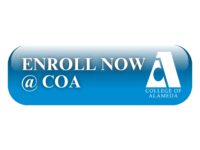- Syllabus and Materials for Chem 1A
Description:
Chem 1A is a one semester college general chemistry course. Atomic structure, the periodic table, molecular structure and bonding, chemical reactions, the mole concept, stoichiometry, gas laws, thermochemistry, solutions, colligative properties, equilibrium, and phase diagrams will be addressed. 13 to 16 chapters will be covered in 16 weeks (or about 1 chapter per week). Problem solving and critical thinking skills are emphasized.
Listed bold chapters below from Tro 5th or 6th Edition are covered in the order given:
· Chapter 1 Introduction: Matter, Measurement and Problem Solving
· Chapter 2 Atoms and Elements
· Chapter 3 Molecules and Compounds
· Chapter 4 Chemical Reactions and Chemical Quantities
· Chapter 5 Introduction to Solutions and Aqueous Reactions
· Chapter 6 Gases
· Chapter 8 The Quantum Mechanical Model of the Atom
· Chapter 9 Periodic Properties of the Elements
· Chapter 10 Chemical Bonding I: The Lewis Model
· Chapter 11 Chemical Bonding II: Molecular Shapes, Valence Bond Theory and MO Theory.
· Chapter 7 Thermochemistry
· Chapter 12 Liquids, Solids, and Intermolecular Forces
· Chapter 14 Solutions
Additional topics may be covered as time permits:
· Chapter 13 Solids and Modern Materials
· Chapter 16 Chemical Equilibrium
· Chapter 17 Acids and Bases
Times and places:
- Lecture – MoWe 11:30 AM – 12:45 PM in D-119 main campus (section 20796).
- Lab – MoWe 1:00 AM – 3:50 AM (section 20797) in room 150 at 860 Atlantic for wet lab or D-119 main campus for required problem sessions and supplemental lectures.
Instructor: Peter Olds
- E-mail: peter.chem1a.coa@gmail.com
- Office Hours: TBA or by appointment or leave message.
Required Course Materials:
- eText: Chemistry 5th or 6th Edition by Tro ($10.99/mo). Most exam questions come from Tro.
- Gen chem hardcopy textbook for open book exams. Recommend Petrucci General Chemistry. (under $10 at ebay.)
- ALEKS for General Chemistry account.
one semester access about $85 (18 weeks online purchase)two semester access about $115 (52 weeks online purchase). - Laptop computer with broadband internet access
- Scientific calculator (graphing calculators and cell phones not allowed during exams)
- Laboratory notebook and lab safety glasses.
Lab Safety Note: No sandals, shorts, food, or drink allowed in the lab! Protective shoes and clothing are required.
Exam Schedule:
- Exam 1 on Chapters 1, 2 and 3
- Exam 2 on Chapters 4, 5 and 6
- Exam 3 on Chapters 8, 9, 10 and 11
- Comprehensive ACS Final Exam including Chapters 7, 12, 14 and 13
Grading Scheme:
- 50% Exams (Exams 1, 2 and 3 are 10% each. Final exam is 20%.).
- 20% ALEKS General Chemistry (adaptive homework and assessments progress).
- 20% Labs (attendance, bench work and lab reports required).
- 10% Class participation including attendance, office hours, problem solving sessions and discussions.
STUDENT LEARNING OUTCOMES ADDENDUM
Course Number: Chem 1A
Course Title: General Chemistry
|
Course Level Student Learning |
Assessment Methods |
|
1. Solve quantitative chemistry |
Biweekly tests, a mid-term exam |
|
2. Describe and explain chemical
|
Biweekly tests, a mid-term exam |
|
3. Safely carry out chemistry experiments in the lab,
|
Weekly experiments will be carried |
220

